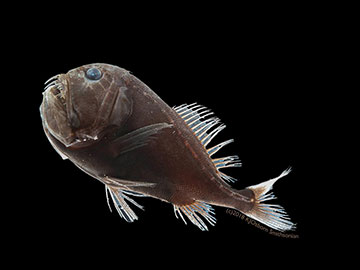![]()
This deep-sea dragonfish has ultra-black skin capable of absorbing the bioluminescent light that might blow its cover. [Image: Karen Osborn, Smithsonian National Museum of Natural History]
In deep oceanic trenches where the sun never shines, some sea creatures light themselves up like an urban billboard. Many others evolved to reflect as little of the bioluminescence as possible—the fish world’s equivalent of stealth technology.
Curious about the deep-black coloration of these fish species, scientists at two U.S. laboratories examined specimens of 16 species with this natural camouflage (Current Biology, doi: 10.1016/j.cub.2020.06.044). The fish reflect less than 0.5% of the light falling on their skin thanks to layers of densely packed melanosomes, or melanin-transporting organelles within cells called melanocytes. These melanosomes, the researchers concluded, evolved in size and shape to scatter as much light within the dermal skin layer and increase light absorption by the melanin itself.
Dark waters, few photons
At depths below 200 m, seawater filters out almost all the sunlight falling on the ocean’s surface. The creatures that inhabit this zone have a vision budget of few photons, so that the slightest bit of reflected bioluminescence could reveal the presence of a predator’s next meal. Likewise, a black carnivorous fish could use its bioluminescent “lamp” to attract prey while keeping the rest of its body hidden from the prospective food. Thus, some deep-sea animals evolved with a coloration that rivals the efforts of materials scientists to create super-light-absorbing pigments for sensitive optical equipment.
One of the scientists in the study, zoologist Karen Osborn of the Smithsonian Institution’s National Museum of Natural History, USA, says her motivation to study these deep-sea ultra-black fish was her difficulties in photographing the details of their anatomy.
“I had tried to photograph deep-sea fish occasionally over the years and was curious why I could never get photos with any decent details visible. “No matter what I did with the lighting and settings I just got silhouettes,” she says. “The fish just seemed to soak up any light I hit it with.”
Camouflage evolution

One specimen of the ultra-black fish species Anoplogaster cornuta. A unique arrangement of pigment-packed granules enables this fish to absorb nearly all of the light that hits its skin, so that as little as 0.05 percent of that light is reflected back. [Image: Karen Osborn, Smithsonian National Museum of Natural History]
Osborn and colleagues from Duke University, USA, collected living specimens of 18 fish species from the Gulf of Mexico and Monterey Bay, California, and measured their skin with a back-reflectance probe. Sixteen of the 18 species reflected less than 0.5% of light at a wavelength of 480 nm, which is the spectral peak of the tiny bit of sunlight that penetrates down to the fishes’ natural habitat. By contrast, a sheet of black paper still reflects 10% of incident light.
Next, the biologists aimed scanning electron microscopes and transmission electron microscopes at their piscine skin samples to get a closer look at the cellular structures. In many cases, the melanosomes were so closely packed that there were few or no unpigmented gaps between them. Fish that are dark colored but not ultra-black separate their melanosomes with gaps of collagen and other colorless substances.
The scientists described the melanosome sizes in terms of “sphere equivalent diameter,” or SED—the diameter of a sphere that would have the same volume as a melanosome. All of these melanosomes fell below 1 μm in SED—in the range of 440 nm to 785 nm.
Finally, 3D finite-difference time-domain (FDTD) simulations of closely packed melanosomes revealed just how well these organelles have been optimized for stealth levels of reflectance. Unlike many black land animals, the packed arrangement of the melanosomes within the piscine skin is solely responsible for the internal light scattering and low reflectance, without the need for chitin or keratin matrices.
Going deeper
Osborn says she is most interested in studying “convergence of these many different fish groups that have arrived at basically the same solution to camouflaging in the dark, vast open space of the deep sea.”
The lead author, Alexander Davis, a doctoral student in Sőnke Johnsen’s biology lab at Duke, will continue to study how this ultra-black camouflage changes over the course of an animal’s life. “Some of these animals are only ultra-black as juveniles and then become less black as they get larger,” he says. “Additionally, I want to explore whether this same pigment packing mechanism can be used with different pigments to create super-saturated colors.”
